Musculoskeletal Disorders and Assistive Technology
VerifiedAdded on 2020/03/16
|16
|3622
|313
AI Summary
This assignment delves into the realm of musculoskeletal disorders (MSDs), focusing particularly on Duchenne muscular dystrophy (DMD) and Becker muscular dystrophy (BMD). It examines their prevalence, symptoms, and impact on motor function. The discussion also explores assistive technologies, including exoskeletons, designed to alleviate the burden of MSDs and enhance mobility for individuals with these conditions.
Contribute Materials
Your contribution can guide someone’s learning journey. Share your
documents today.

Running head: ERGONOMICS
Ergonomics
Name of the Student
Name of the University
Author note
Ergonomics
Name of the Student
Name of the University
Author note
Secure Best Marks with AI Grader
Need help grading? Try our AI Grader for instant feedback on your assignments.
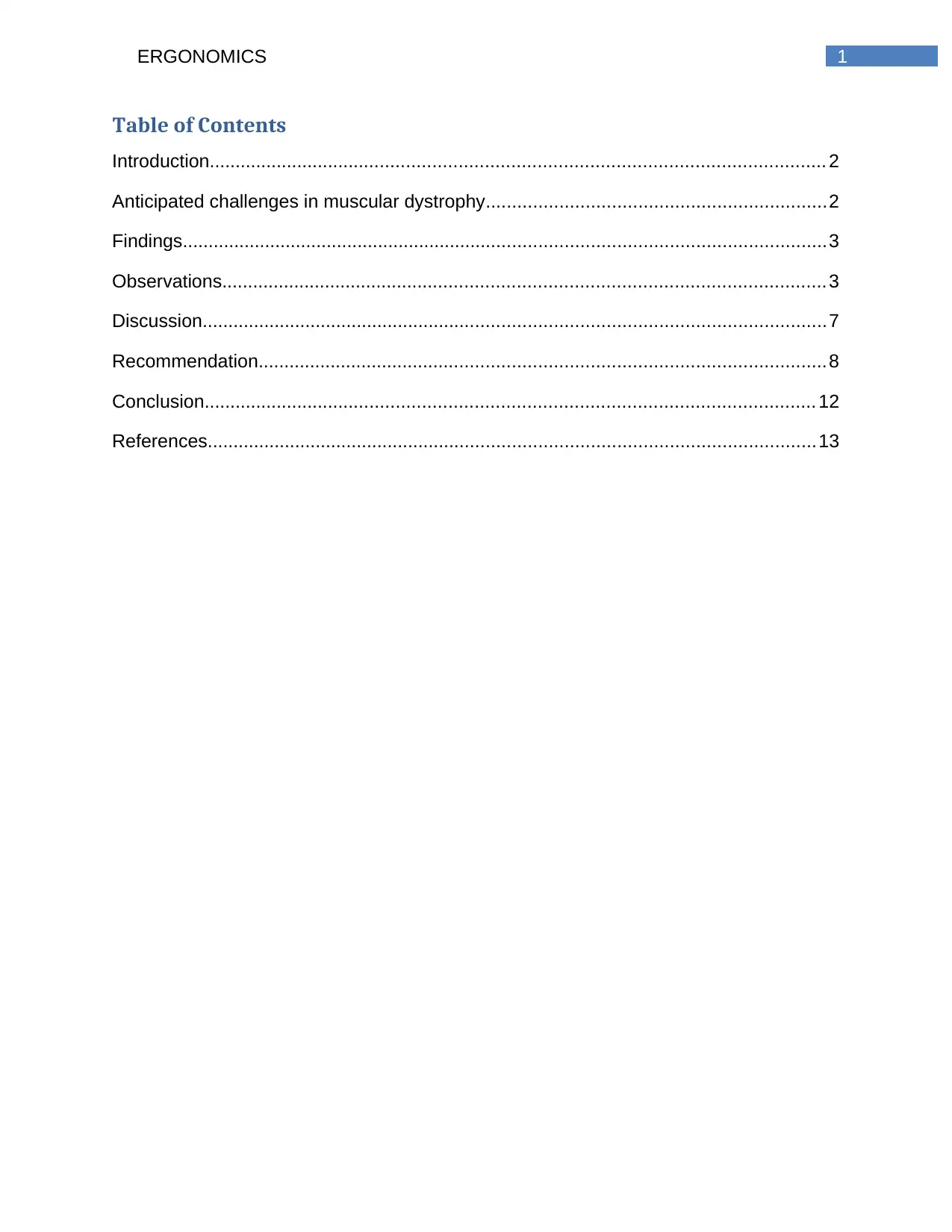
1ERGONOMICS
Table of Contents
Introduction...................................................................................................................... 2
Anticipated challenges in muscular dystrophy.................................................................2
Findings............................................................................................................................3
Observations.................................................................................................................... 3
Discussion........................................................................................................................7
Recommendation.............................................................................................................8
Conclusion..................................................................................................................... 12
References.....................................................................................................................13
Table of Contents
Introduction...................................................................................................................... 2
Anticipated challenges in muscular dystrophy.................................................................2
Findings............................................................................................................................3
Observations.................................................................................................................... 3
Discussion........................................................................................................................7
Recommendation.............................................................................................................8
Conclusion..................................................................................................................... 12
References.....................................................................................................................13
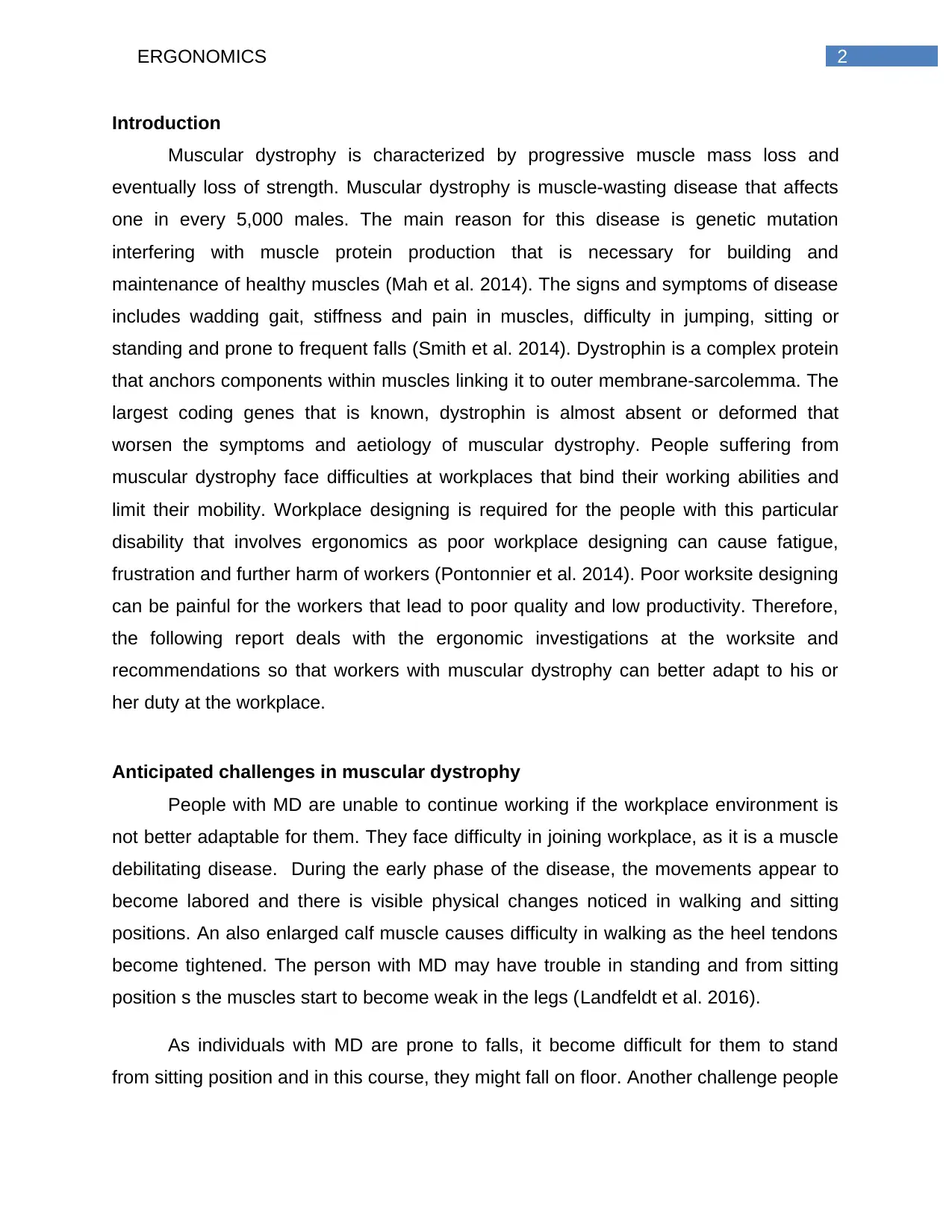
2ERGONOMICS
Introduction
Muscular dystrophy is characterized by progressive muscle mass loss and
eventually loss of strength. Muscular dystrophy is muscle-wasting disease that affects
one in every 5,000 males. The main reason for this disease is genetic mutation
interfering with muscle protein production that is necessary for building and
maintenance of healthy muscles (Mah et al. 2014). The signs and symptoms of disease
includes wadding gait, stiffness and pain in muscles, difficulty in jumping, sitting or
standing and prone to frequent falls (Smith et al. 2014). Dystrophin is a complex protein
that anchors components within muscles linking it to outer membrane-sarcolemma. The
largest coding genes that is known, dystrophin is almost absent or deformed that
worsen the symptoms and aetiology of muscular dystrophy. People suffering from
muscular dystrophy face difficulties at workplaces that bind their working abilities and
limit their mobility. Workplace designing is required for the people with this particular
disability that involves ergonomics as poor workplace designing can cause fatigue,
frustration and further harm of workers (Pontonnier et al. 2014). Poor worksite designing
can be painful for the workers that lead to poor quality and low productivity. Therefore,
the following report deals with the ergonomic investigations at the worksite and
recommendations so that workers with muscular dystrophy can better adapt to his or
her duty at the workplace.
Anticipated challenges in muscular dystrophy
People with MD are unable to continue working if the workplace environment is
not better adaptable for them. They face difficulty in joining workplace, as it is a muscle
debilitating disease. During the early phase of the disease, the movements appear to
become labored and there is visible physical changes noticed in walking and sitting
positions. An also enlarged calf muscle causes difficulty in walking as the heel tendons
become tightened. The person with MD may have trouble in standing and from sitting
position s the muscles start to become weak in the legs (Landfeldt et al. 2016).
As individuals with MD are prone to falls, it become difficult for them to stand
from sitting position and in this course, they might fall on floor. Another challenge people
Introduction
Muscular dystrophy is characterized by progressive muscle mass loss and
eventually loss of strength. Muscular dystrophy is muscle-wasting disease that affects
one in every 5,000 males. The main reason for this disease is genetic mutation
interfering with muscle protein production that is necessary for building and
maintenance of healthy muscles (Mah et al. 2014). The signs and symptoms of disease
includes wadding gait, stiffness and pain in muscles, difficulty in jumping, sitting or
standing and prone to frequent falls (Smith et al. 2014). Dystrophin is a complex protein
that anchors components within muscles linking it to outer membrane-sarcolemma. The
largest coding genes that is known, dystrophin is almost absent or deformed that
worsen the symptoms and aetiology of muscular dystrophy. People suffering from
muscular dystrophy face difficulties at workplaces that bind their working abilities and
limit their mobility. Workplace designing is required for the people with this particular
disability that involves ergonomics as poor workplace designing can cause fatigue,
frustration and further harm of workers (Pontonnier et al. 2014). Poor worksite designing
can be painful for the workers that lead to poor quality and low productivity. Therefore,
the following report deals with the ergonomic investigations at the worksite and
recommendations so that workers with muscular dystrophy can better adapt to his or
her duty at the workplace.
Anticipated challenges in muscular dystrophy
People with MD are unable to continue working if the workplace environment is
not better adaptable for them. They face difficulty in joining workplace, as it is a muscle
debilitating disease. During the early phase of the disease, the movements appear to
become labored and there is visible physical changes noticed in walking and sitting
positions. An also enlarged calf muscle causes difficulty in walking as the heel tendons
become tightened. The person with MD may have trouble in standing and from sitting
position s the muscles start to become weak in the legs (Landfeldt et al. 2016).
As individuals with MD are prone to falls, it become difficult for them to stand
from sitting position and in this course, they might fall on floor. Another challenge people
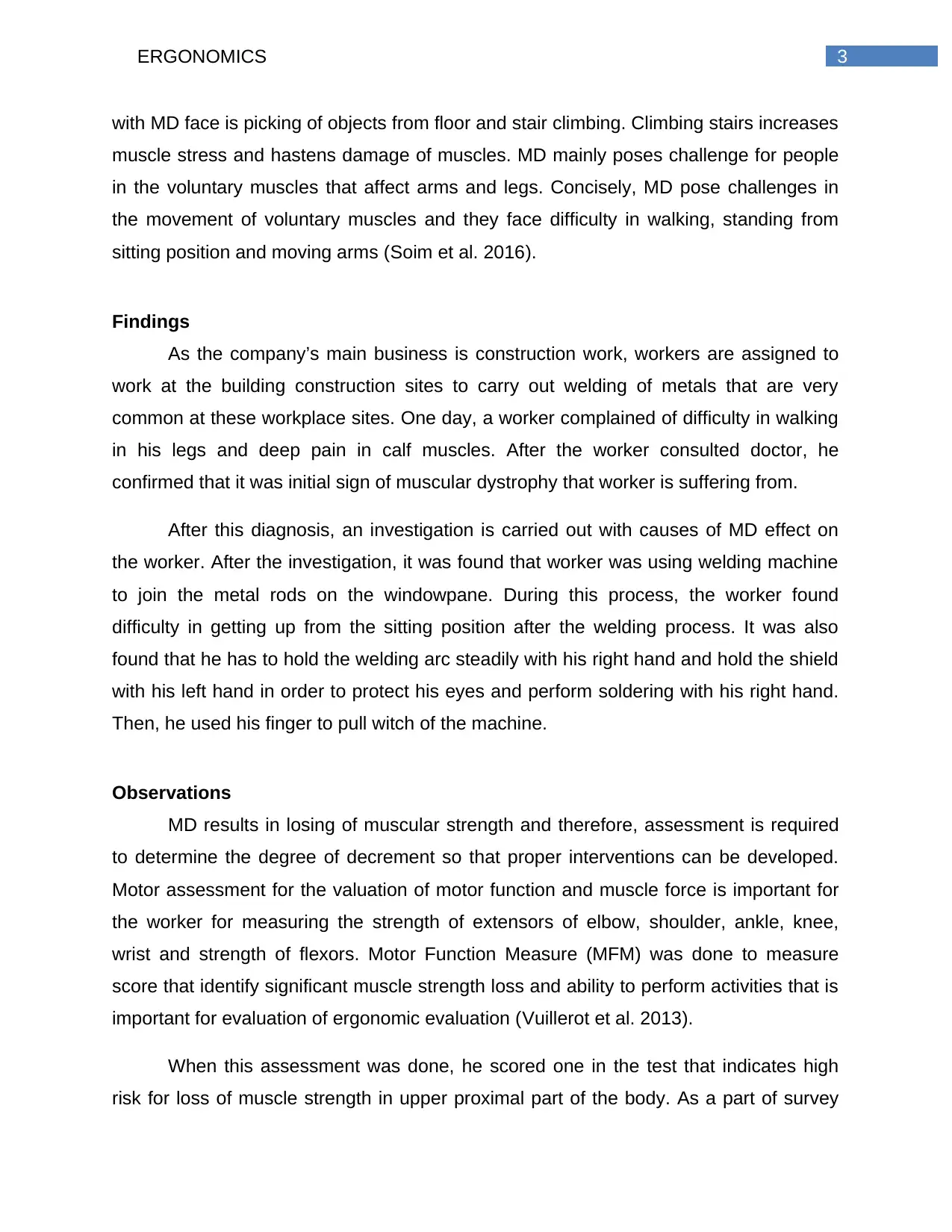
3ERGONOMICS
with MD face is picking of objects from floor and stair climbing. Climbing stairs increases
muscle stress and hastens damage of muscles. MD mainly poses challenge for people
in the voluntary muscles that affect arms and legs. Concisely, MD pose challenges in
the movement of voluntary muscles and they face difficulty in walking, standing from
sitting position and moving arms (Soim et al. 2016).
Findings
As the company’s main business is construction work, workers are assigned to
work at the building construction sites to carry out welding of metals that are very
common at these workplace sites. One day, a worker complained of difficulty in walking
in his legs and deep pain in calf muscles. After the worker consulted doctor, he
confirmed that it was initial sign of muscular dystrophy that worker is suffering from.
After this diagnosis, an investigation is carried out with causes of MD effect on
the worker. After the investigation, it was found that worker was using welding machine
to join the metal rods on the windowpane. During this process, the worker found
difficulty in getting up from the sitting position after the welding process. It was also
found that he has to hold the welding arc steadily with his right hand and hold the shield
with his left hand in order to protect his eyes and perform soldering with his right hand.
Then, he used his finger to pull witch of the machine.
Observations
MD results in losing of muscular strength and therefore, assessment is required
to determine the degree of decrement so that proper interventions can be developed.
Motor assessment for the valuation of motor function and muscle force is important for
the worker for measuring the strength of extensors of elbow, shoulder, ankle, knee,
wrist and strength of flexors. Motor Function Measure (MFM) was done to measure
score that identify significant muscle strength loss and ability to perform activities that is
important for evaluation of ergonomic evaluation (Vuillerot et al. 2013).
When this assessment was done, he scored one in the test that indicates high
risk for loss of muscle strength in upper proximal part of the body. As a part of survey
with MD face is picking of objects from floor and stair climbing. Climbing stairs increases
muscle stress and hastens damage of muscles. MD mainly poses challenge for people
in the voluntary muscles that affect arms and legs. Concisely, MD pose challenges in
the movement of voluntary muscles and they face difficulty in walking, standing from
sitting position and moving arms (Soim et al. 2016).
Findings
As the company’s main business is construction work, workers are assigned to
work at the building construction sites to carry out welding of metals that are very
common at these workplace sites. One day, a worker complained of difficulty in walking
in his legs and deep pain in calf muscles. After the worker consulted doctor, he
confirmed that it was initial sign of muscular dystrophy that worker is suffering from.
After this diagnosis, an investigation is carried out with causes of MD effect on
the worker. After the investigation, it was found that worker was using welding machine
to join the metal rods on the windowpane. During this process, the worker found
difficulty in getting up from the sitting position after the welding process. It was also
found that he has to hold the welding arc steadily with his right hand and hold the shield
with his left hand in order to protect his eyes and perform soldering with his right hand.
Then, he used his finger to pull witch of the machine.
Observations
MD results in losing of muscular strength and therefore, assessment is required
to determine the degree of decrement so that proper interventions can be developed.
Motor assessment for the valuation of motor function and muscle force is important for
the worker for measuring the strength of extensors of elbow, shoulder, ankle, knee,
wrist and strength of flexors. Motor Function Measure (MFM) was done to measure
score that identify significant muscle strength loss and ability to perform activities that is
important for evaluation of ergonomic evaluation (Vuillerot et al. 2013).
When this assessment was done, he scored one in the test that indicates high
risk for loss of muscle strength in upper proximal part of the body. As a part of survey
Secure Best Marks with AI Grader
Need help grading? Try our AI Grader for instant feedback on your assignments.
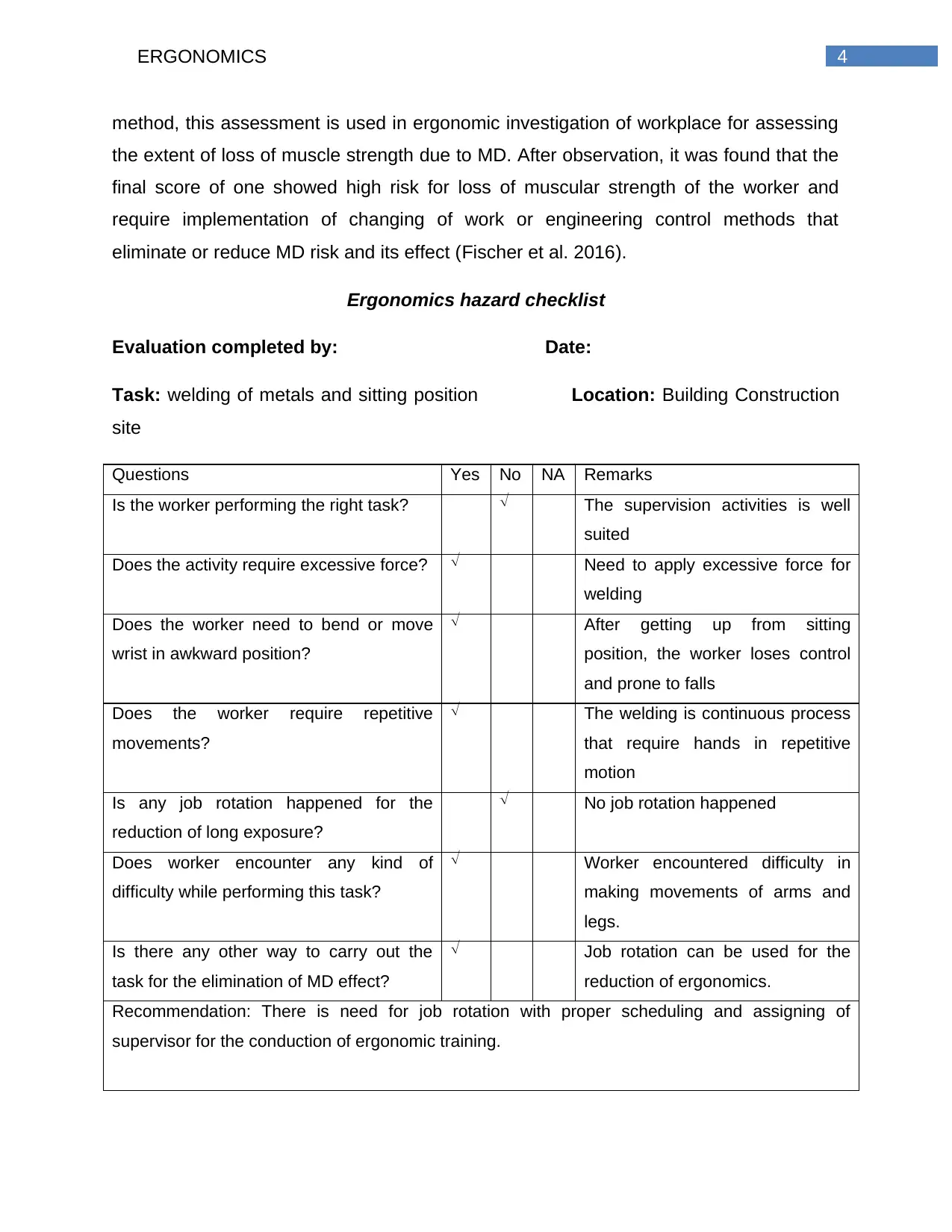
4ERGONOMICS
method, this assessment is used in ergonomic investigation of workplace for assessing
the extent of loss of muscle strength due to MD. After observation, it was found that the
final score of one showed high risk for loss of muscular strength of the worker and
require implementation of changing of work or engineering control methods that
eliminate or reduce MD risk and its effect (Fischer et al. 2016).
Ergonomics hazard checklist
Evaluation completed by: Date:
Task: welding of metals and sitting position Location: Building Construction
site
Questions Yes No NA Remarks
Is the worker performing the right task? The supervision activities is well
suited
Does the activity require excessive force? Need to apply excessive force for
welding
Does the worker need to bend or move
wrist in awkward position?
After getting up from sitting
position, the worker loses control
and prone to falls
Does the worker require repetitive
movements?
The welding is continuous process
that require hands in repetitive
motion
Is any job rotation happened for the
reduction of long exposure?
No job rotation happened
Does worker encounter any kind of
difficulty while performing this task?
Worker encountered difficulty in
making movements of arms and
legs.
Is there any other way to carry out the
task for the elimination of MD effect?
Job rotation can be used for the
reduction of ergonomics.
Recommendation: There is need for job rotation with proper scheduling and assigning of
supervisor for the conduction of ergonomic training.
method, this assessment is used in ergonomic investigation of workplace for assessing
the extent of loss of muscle strength due to MD. After observation, it was found that the
final score of one showed high risk for loss of muscular strength of the worker and
require implementation of changing of work or engineering control methods that
eliminate or reduce MD risk and its effect (Fischer et al. 2016).
Ergonomics hazard checklist
Evaluation completed by: Date:
Task: welding of metals and sitting position Location: Building Construction
site
Questions Yes No NA Remarks
Is the worker performing the right task? The supervision activities is well
suited
Does the activity require excessive force? Need to apply excessive force for
welding
Does the worker need to bend or move
wrist in awkward position?
After getting up from sitting
position, the worker loses control
and prone to falls
Does the worker require repetitive
movements?
The welding is continuous process
that require hands in repetitive
motion
Is any job rotation happened for the
reduction of long exposure?
No job rotation happened
Does worker encounter any kind of
difficulty while performing this task?
Worker encountered difficulty in
making movements of arms and
legs.
Is there any other way to carry out the
task for the elimination of MD effect?
Job rotation can be used for the
reduction of ergonomics.
Recommendation: There is need for job rotation with proper scheduling and assigning of
supervisor for the conduction of ergonomic training.
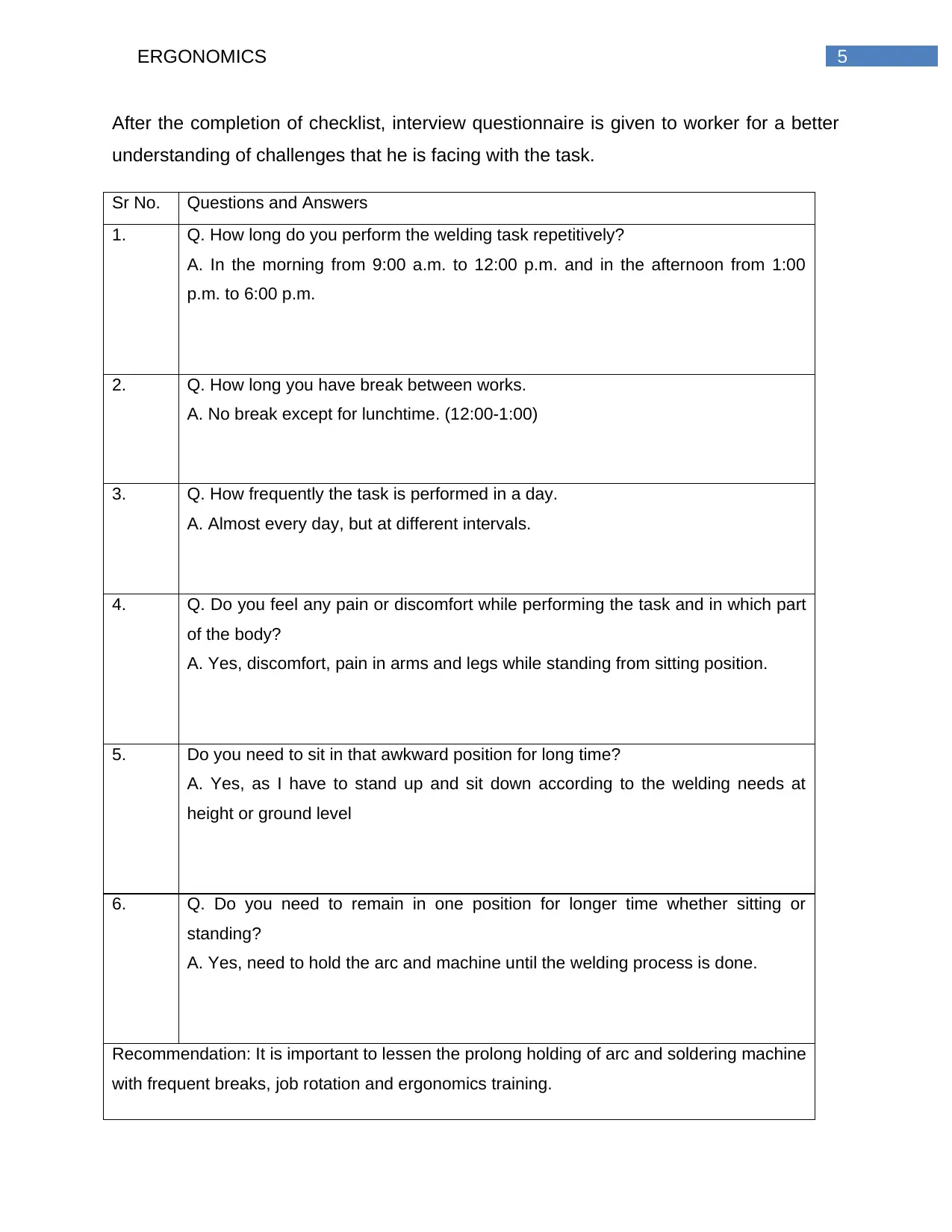
5ERGONOMICS
After the completion of checklist, interview questionnaire is given to worker for a better
understanding of challenges that he is facing with the task.
Sr No. Questions and Answers
1. Q. How long do you perform the welding task repetitively?
A. In the morning from 9:00 a.m. to 12:00 p.m. and in the afternoon from 1:00
p.m. to 6:00 p.m.
2. Q. How long you have break between works.
A. No break except for lunchtime. (12:00-1:00)
3. Q. How frequently the task is performed in a day.
A. Almost every day, but at different intervals.
4. Q. Do you feel any pain or discomfort while performing the task and in which part
of the body?
A. Yes, discomfort, pain in arms and legs while standing from sitting position.
5. Do you need to sit in that awkward position for long time?
A. Yes, as I have to stand up and sit down according to the welding needs at
height or ground level
6. Q. Do you need to remain in one position for longer time whether sitting or
standing?
A. Yes, need to hold the arc and machine until the welding process is done.
Recommendation: It is important to lessen the prolong holding of arc and soldering machine
with frequent breaks, job rotation and ergonomics training.
After the completion of checklist, interview questionnaire is given to worker for a better
understanding of challenges that he is facing with the task.
Sr No. Questions and Answers
1. Q. How long do you perform the welding task repetitively?
A. In the morning from 9:00 a.m. to 12:00 p.m. and in the afternoon from 1:00
p.m. to 6:00 p.m.
2. Q. How long you have break between works.
A. No break except for lunchtime. (12:00-1:00)
3. Q. How frequently the task is performed in a day.
A. Almost every day, but at different intervals.
4. Q. Do you feel any pain or discomfort while performing the task and in which part
of the body?
A. Yes, discomfort, pain in arms and legs while standing from sitting position.
5. Do you need to sit in that awkward position for long time?
A. Yes, as I have to stand up and sit down according to the welding needs at
height or ground level
6. Q. Do you need to remain in one position for longer time whether sitting or
standing?
A. Yes, need to hold the arc and machine until the welding process is done.
Recommendation: It is important to lessen the prolong holding of arc and soldering machine
with frequent breaks, job rotation and ergonomics training.
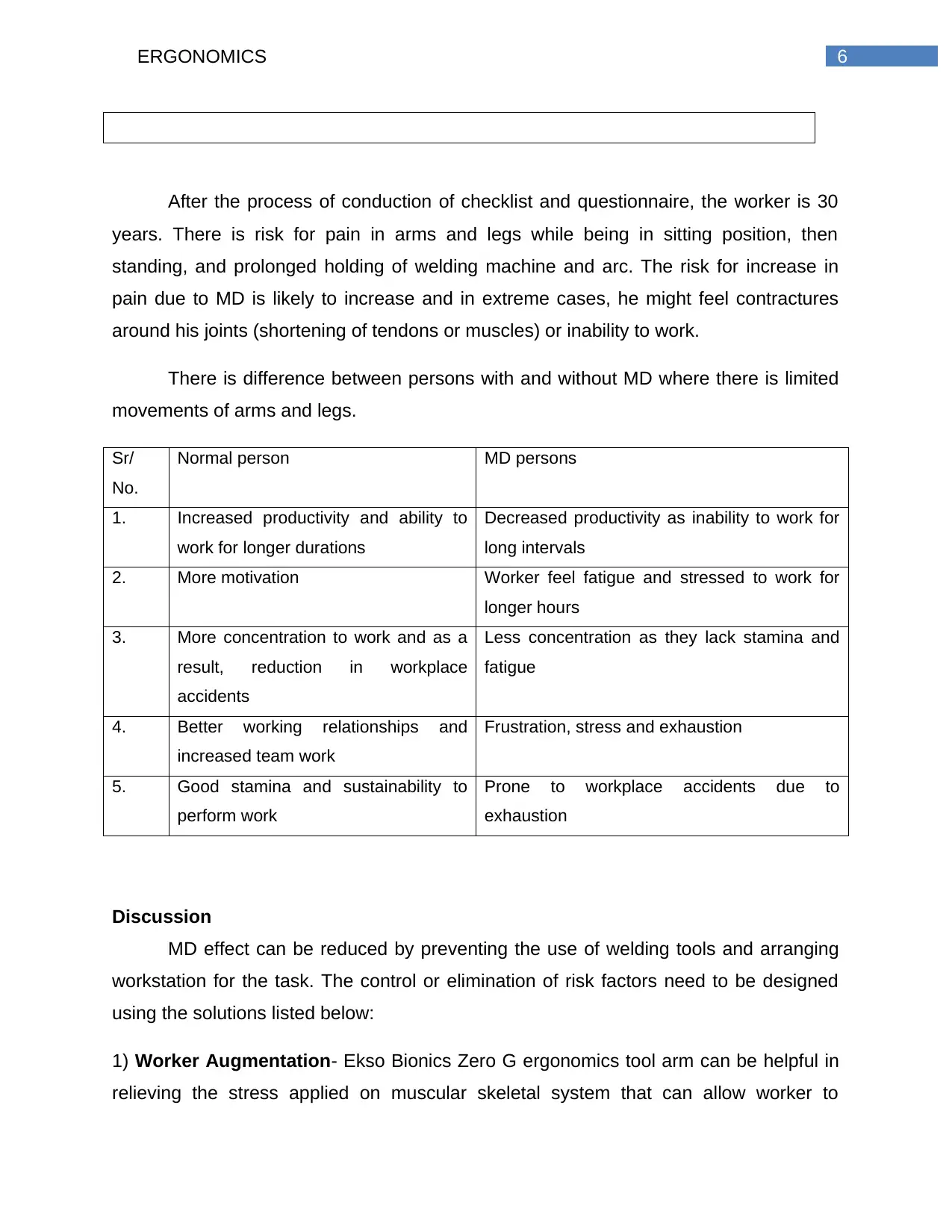
6ERGONOMICS
After the process of conduction of checklist and questionnaire, the worker is 30
years. There is risk for pain in arms and legs while being in sitting position, then
standing, and prolonged holding of welding machine and arc. The risk for increase in
pain due to MD is likely to increase and in extreme cases, he might feel contractures
around his joints (shortening of tendons or muscles) or inability to work.
There is difference between persons with and without MD where there is limited
movements of arms and legs.
Sr/
No.
Normal person MD persons
1. Increased productivity and ability to
work for longer durations
Decreased productivity as inability to work for
long intervals
2. More motivation Worker feel fatigue and stressed to work for
longer hours
3. More concentration to work and as a
result, reduction in workplace
accidents
Less concentration as they lack stamina and
fatigue
4. Better working relationships and
increased team work
Frustration, stress and exhaustion
5. Good stamina and sustainability to
perform work
Prone to workplace accidents due to
exhaustion
Discussion
MD effect can be reduced by preventing the use of welding tools and arranging
workstation for the task. The control or elimination of risk factors need to be designed
using the solutions listed below:
1) Worker Augmentation- Ekso Bionics Zero G ergonomics tool arm can be helpful in
relieving the stress applied on muscular skeletal system that can allow worker to
After the process of conduction of checklist and questionnaire, the worker is 30
years. There is risk for pain in arms and legs while being in sitting position, then
standing, and prolonged holding of welding machine and arc. The risk for increase in
pain due to MD is likely to increase and in extreme cases, he might feel contractures
around his joints (shortening of tendons or muscles) or inability to work.
There is difference between persons with and without MD where there is limited
movements of arms and legs.
Sr/
No.
Normal person MD persons
1. Increased productivity and ability to
work for longer durations
Decreased productivity as inability to work for
long intervals
2. More motivation Worker feel fatigue and stressed to work for
longer hours
3. More concentration to work and as a
result, reduction in workplace
accidents
Less concentration as they lack stamina and
fatigue
4. Better working relationships and
increased team work
Frustration, stress and exhaustion
5. Good stamina and sustainability to
perform work
Prone to workplace accidents due to
exhaustion
Discussion
MD effect can be reduced by preventing the use of welding tools and arranging
workstation for the task. The control or elimination of risk factors need to be designed
using the solutions listed below:
1) Worker Augmentation- Ekso Bionics Zero G ergonomics tool arm can be helpful in
relieving the stress applied on muscular skeletal system that can allow worker to
Paraphrase This Document
Need a fresh take? Get an instant paraphrase of this document with our AI Paraphraser
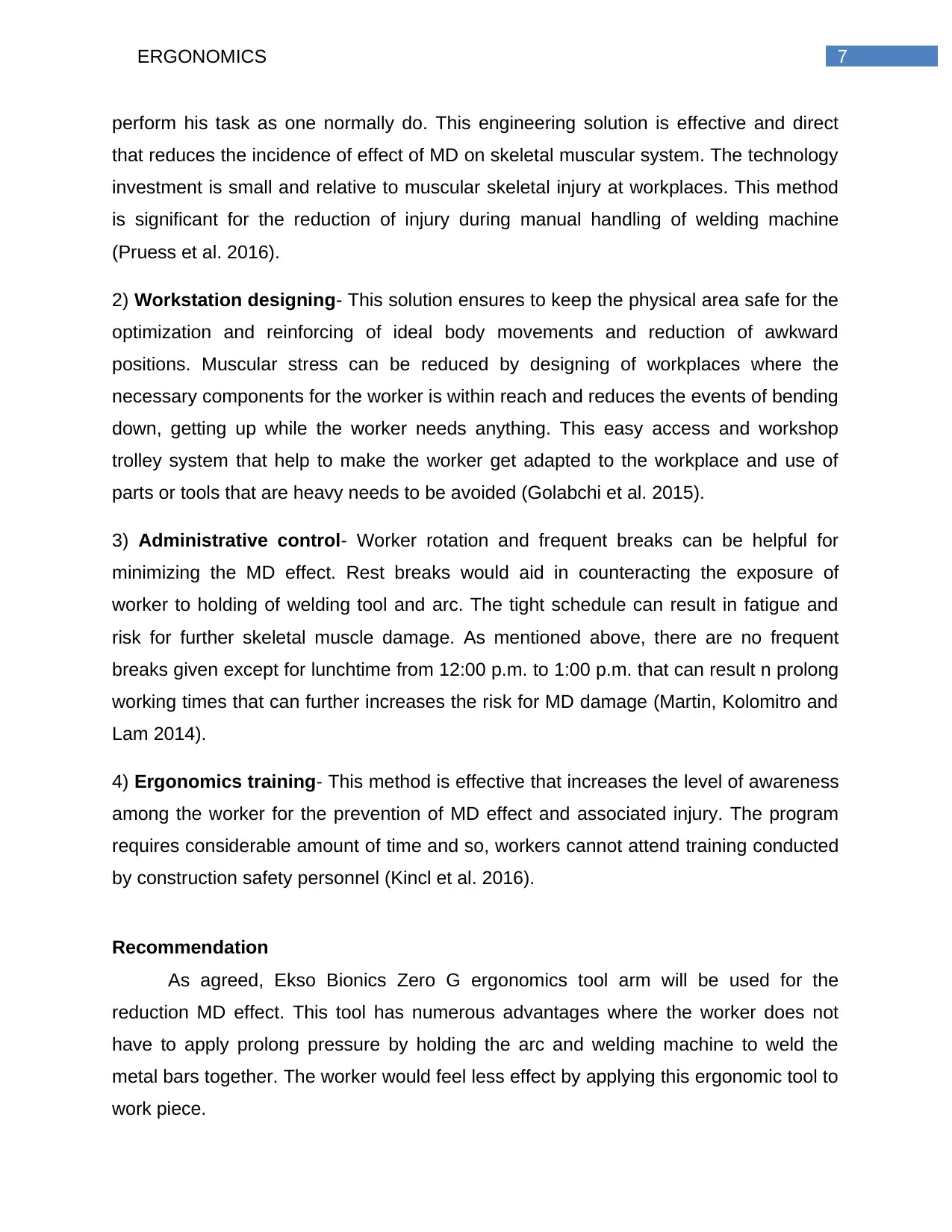
7ERGONOMICS
perform his task as one normally do. This engineering solution is effective and direct
that reduces the incidence of effect of MD on skeletal muscular system. The technology
investment is small and relative to muscular skeletal injury at workplaces. This method
is significant for the reduction of injury during manual handling of welding machine
(Pruess et al. 2016).
2) Workstation designing- This solution ensures to keep the physical area safe for the
optimization and reinforcing of ideal body movements and reduction of awkward
positions. Muscular stress can be reduced by designing of workplaces where the
necessary components for the worker is within reach and reduces the events of bending
down, getting up while the worker needs anything. This easy access and workshop
trolley system that help to make the worker get adapted to the workplace and use of
parts or tools that are heavy needs to be avoided (Golabchi et al. 2015).
3) Administrative control- Worker rotation and frequent breaks can be helpful for
minimizing the MD effect. Rest breaks would aid in counteracting the exposure of
worker to holding of welding tool and arc. The tight schedule can result in fatigue and
risk for further skeletal muscle damage. As mentioned above, there are no frequent
breaks given except for lunchtime from 12:00 p.m. to 1:00 p.m. that can result n prolong
working times that can further increases the risk for MD damage (Martin, Kolomitro and
Lam 2014).
4) Ergonomics training- This method is effective that increases the level of awareness
among the worker for the prevention of MD effect and associated injury. The program
requires considerable amount of time and so, workers cannot attend training conducted
by construction safety personnel (Kincl et al. 2016).
Recommendation
As agreed, Ekso Bionics Zero G ergonomics tool arm will be used for the
reduction MD effect. This tool has numerous advantages where the worker does not
have to apply prolong pressure by holding the arc and welding machine to weld the
metal bars together. The worker would feel less effect by applying this ergonomic tool to
work piece.
perform his task as one normally do. This engineering solution is effective and direct
that reduces the incidence of effect of MD on skeletal muscular system. The technology
investment is small and relative to muscular skeletal injury at workplaces. This method
is significant for the reduction of injury during manual handling of welding machine
(Pruess et al. 2016).
2) Workstation designing- This solution ensures to keep the physical area safe for the
optimization and reinforcing of ideal body movements and reduction of awkward
positions. Muscular stress can be reduced by designing of workplaces where the
necessary components for the worker is within reach and reduces the events of bending
down, getting up while the worker needs anything. This easy access and workshop
trolley system that help to make the worker get adapted to the workplace and use of
parts or tools that are heavy needs to be avoided (Golabchi et al. 2015).
3) Administrative control- Worker rotation and frequent breaks can be helpful for
minimizing the MD effect. Rest breaks would aid in counteracting the exposure of
worker to holding of welding tool and arc. The tight schedule can result in fatigue and
risk for further skeletal muscle damage. As mentioned above, there are no frequent
breaks given except for lunchtime from 12:00 p.m. to 1:00 p.m. that can result n prolong
working times that can further increases the risk for MD damage (Martin, Kolomitro and
Lam 2014).
4) Ergonomics training- This method is effective that increases the level of awareness
among the worker for the prevention of MD effect and associated injury. The program
requires considerable amount of time and so, workers cannot attend training conducted
by construction safety personnel (Kincl et al. 2016).
Recommendation
As agreed, Ekso Bionics Zero G ergonomics tool arm will be used for the
reduction MD effect. This tool has numerous advantages where the worker does not
have to apply prolong pressure by holding the arc and welding machine to weld the
metal bars together. The worker would feel less effect by applying this ergonomic tool to
work piece.
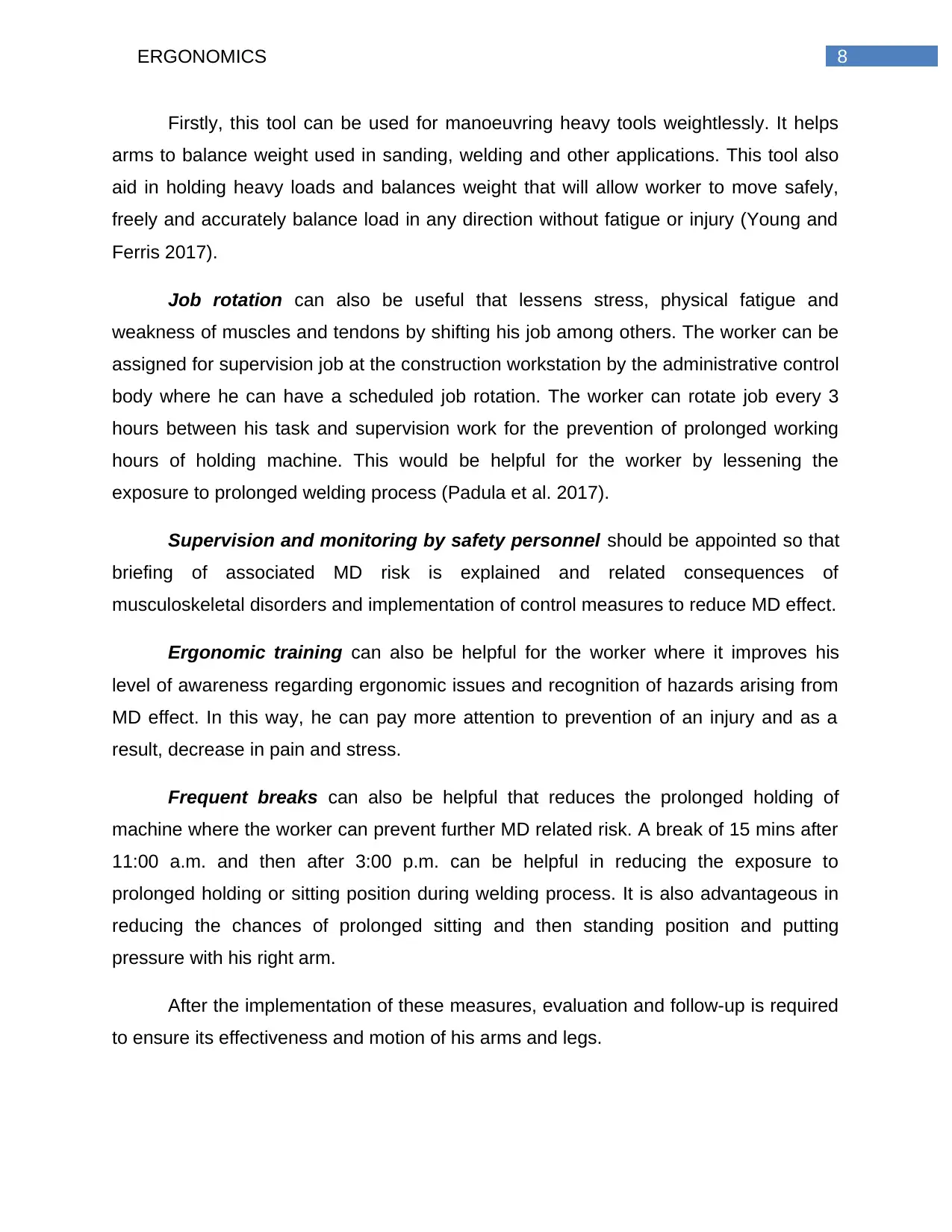
8ERGONOMICS
Firstly, this tool can be used for manoeuvring heavy tools weightlessly. It helps
arms to balance weight used in sanding, welding and other applications. This tool also
aid in holding heavy loads and balances weight that will allow worker to move safely,
freely and accurately balance load in any direction without fatigue or injury (Young and
Ferris 2017).
Job rotation can also be useful that lessens stress, physical fatigue and
weakness of muscles and tendons by shifting his job among others. The worker can be
assigned for supervision job at the construction workstation by the administrative control
body where he can have a scheduled job rotation. The worker can rotate job every 3
hours between his task and supervision work for the prevention of prolonged working
hours of holding machine. This would be helpful for the worker by lessening the
exposure to prolonged welding process (Padula et al. 2017).
Supervision and monitoring by safety personnel should be appointed so that
briefing of associated MD risk is explained and related consequences of
musculoskeletal disorders and implementation of control measures to reduce MD effect.
Ergonomic training can also be helpful for the worker where it improves his
level of awareness regarding ergonomic issues and recognition of hazards arising from
MD effect. In this way, he can pay more attention to prevention of an injury and as a
result, decrease in pain and stress.
Frequent breaks can also be helpful that reduces the prolonged holding of
machine where the worker can prevent further MD related risk. A break of 15 mins after
11:00 a.m. and then after 3:00 p.m. can be helpful in reducing the exposure to
prolonged holding or sitting position during welding process. It is also advantageous in
reducing the chances of prolonged sitting and then standing position and putting
pressure with his right arm.
After the implementation of these measures, evaluation and follow-up is required
to ensure its effectiveness and motion of his arms and legs.
Firstly, this tool can be used for manoeuvring heavy tools weightlessly. It helps
arms to balance weight used in sanding, welding and other applications. This tool also
aid in holding heavy loads and balances weight that will allow worker to move safely,
freely and accurately balance load in any direction without fatigue or injury (Young and
Ferris 2017).
Job rotation can also be useful that lessens stress, physical fatigue and
weakness of muscles and tendons by shifting his job among others. The worker can be
assigned for supervision job at the construction workstation by the administrative control
body where he can have a scheduled job rotation. The worker can rotate job every 3
hours between his task and supervision work for the prevention of prolonged working
hours of holding machine. This would be helpful for the worker by lessening the
exposure to prolonged welding process (Padula et al. 2017).
Supervision and monitoring by safety personnel should be appointed so that
briefing of associated MD risk is explained and related consequences of
musculoskeletal disorders and implementation of control measures to reduce MD effect.
Ergonomic training can also be helpful for the worker where it improves his
level of awareness regarding ergonomic issues and recognition of hazards arising from
MD effect. In this way, he can pay more attention to prevention of an injury and as a
result, decrease in pain and stress.
Frequent breaks can also be helpful that reduces the prolonged holding of
machine where the worker can prevent further MD related risk. A break of 15 mins after
11:00 a.m. and then after 3:00 p.m. can be helpful in reducing the exposure to
prolonged holding or sitting position during welding process. It is also advantageous in
reducing the chances of prolonged sitting and then standing position and putting
pressure with his right arm.
After the implementation of these measures, evaluation and follow-up is required
to ensure its effectiveness and motion of his arms and legs.
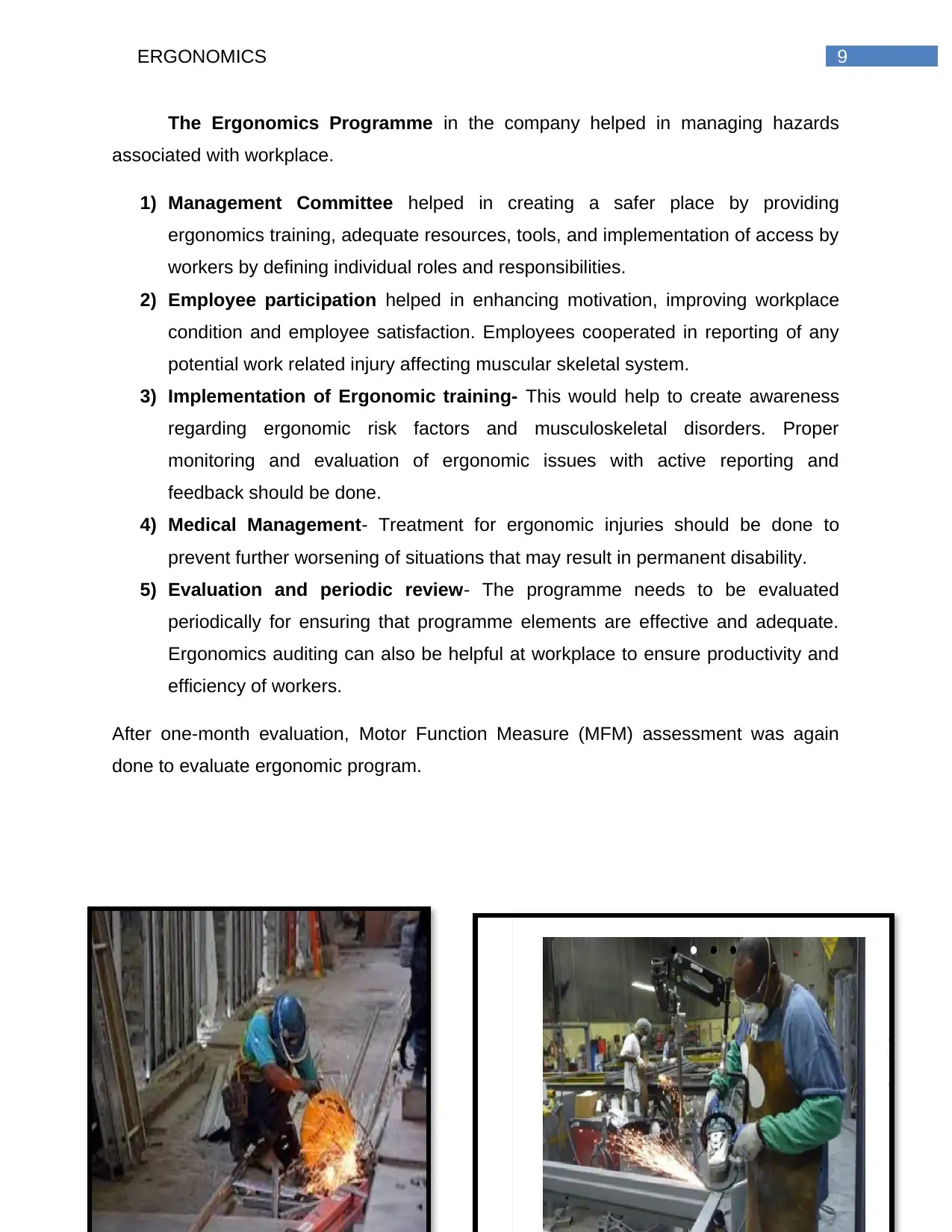
9ERGONOMICS
The Ergonomics Programme in the company helped in managing hazards
associated with workplace.
1) Management Committee helped in creating a safer place by providing
ergonomics training, adequate resources, tools, and implementation of access by
workers by defining individual roles and responsibilities.
2) Employee participation helped in enhancing motivation, improving workplace
condition and employee satisfaction. Employees cooperated in reporting of any
potential work related injury affecting muscular skeletal system.
3) Implementation of Ergonomic training- This would help to create awareness
regarding ergonomic risk factors and musculoskeletal disorders. Proper
monitoring and evaluation of ergonomic issues with active reporting and
feedback should be done.
4) Medical Management- Treatment for ergonomic injuries should be done to
prevent further worsening of situations that may result in permanent disability.
5) Evaluation and periodic review- The programme needs to be evaluated
periodically for ensuring that programme elements are effective and adequate.
Ergonomics auditing can also be helpful at workplace to ensure productivity and
efficiency of workers.
After one-month evaluation, Motor Function Measure (MFM) assessment was again
done to evaluate ergonomic program.
The Ergonomics Programme in the company helped in managing hazards
associated with workplace.
1) Management Committee helped in creating a safer place by providing
ergonomics training, adequate resources, tools, and implementation of access by
workers by defining individual roles and responsibilities.
2) Employee participation helped in enhancing motivation, improving workplace
condition and employee satisfaction. Employees cooperated in reporting of any
potential work related injury affecting muscular skeletal system.
3) Implementation of Ergonomic training- This would help to create awareness
regarding ergonomic risk factors and musculoskeletal disorders. Proper
monitoring and evaluation of ergonomic issues with active reporting and
feedback should be done.
4) Medical Management- Treatment for ergonomic injuries should be done to
prevent further worsening of situations that may result in permanent disability.
5) Evaluation and periodic review- The programme needs to be evaluated
periodically for ensuring that programme elements are effective and adequate.
Ergonomics auditing can also be helpful at workplace to ensure productivity and
efficiency of workers.
After one-month evaluation, Motor Function Measure (MFM) assessment was again
done to evaluate ergonomic program.
Secure Best Marks with AI Grader
Need help grading? Try our AI Grader for instant feedback on your assignments.
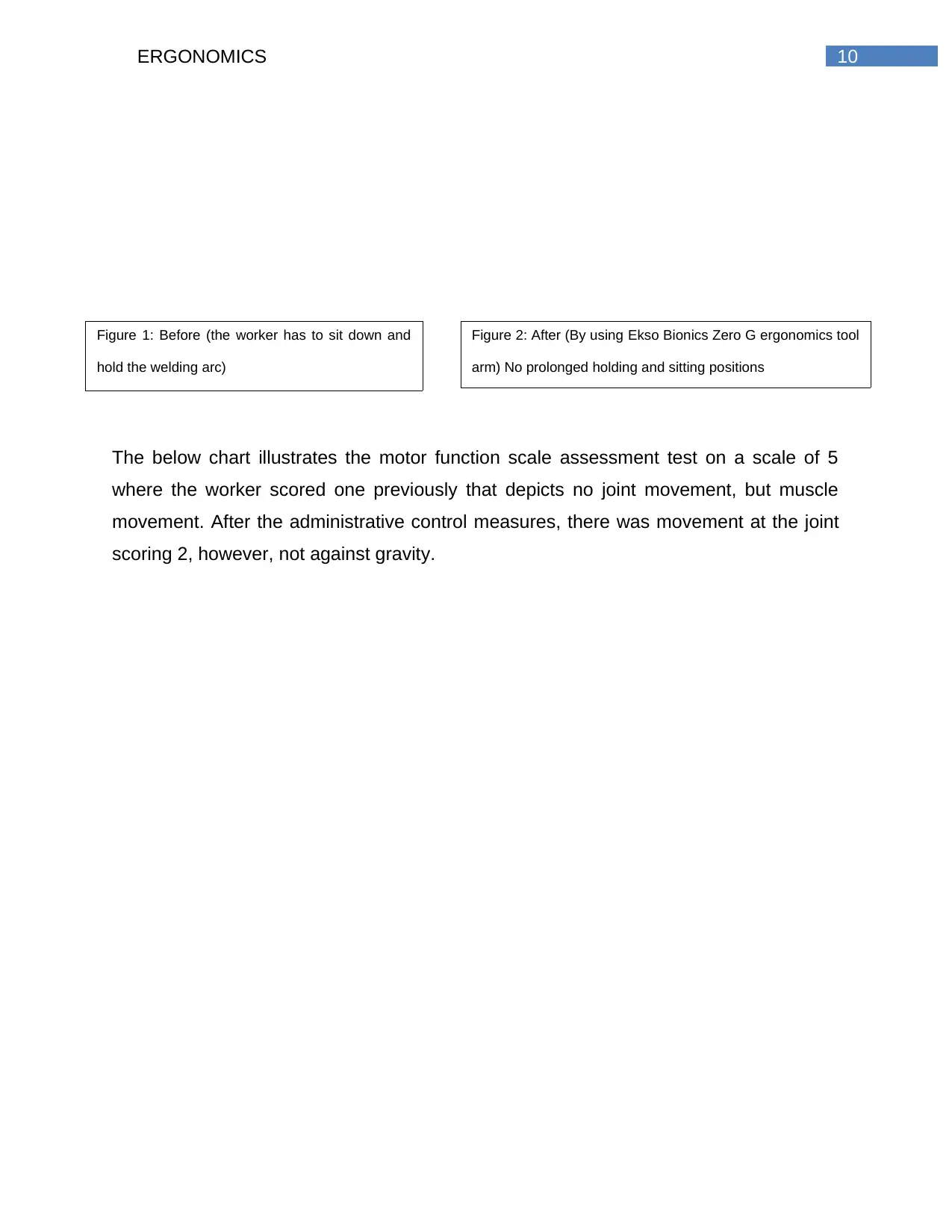
10ERGONOMICS
The below chart illustrates the motor function scale assessment test on a scale of 5
where the worker scored one previously that depicts no joint movement, but muscle
movement. After the administrative control measures, there was movement at the joint
scoring 2, however, not against gravity.
Figure 1: Before (the worker has to sit down and
hold the welding arc)
Figure 2: After (By using Ekso Bionics Zero G ergonomics tool
arm) No prolonged holding and sitting positions
The below chart illustrates the motor function scale assessment test on a scale of 5
where the worker scored one previously that depicts no joint movement, but muscle
movement. After the administrative control measures, there was movement at the joint
scoring 2, however, not against gravity.
Figure 1: Before (the worker has to sit down and
hold the welding arc)
Figure 2: After (By using Ekso Bionics Zero G ergonomics tool
arm) No prolonged holding and sitting positions
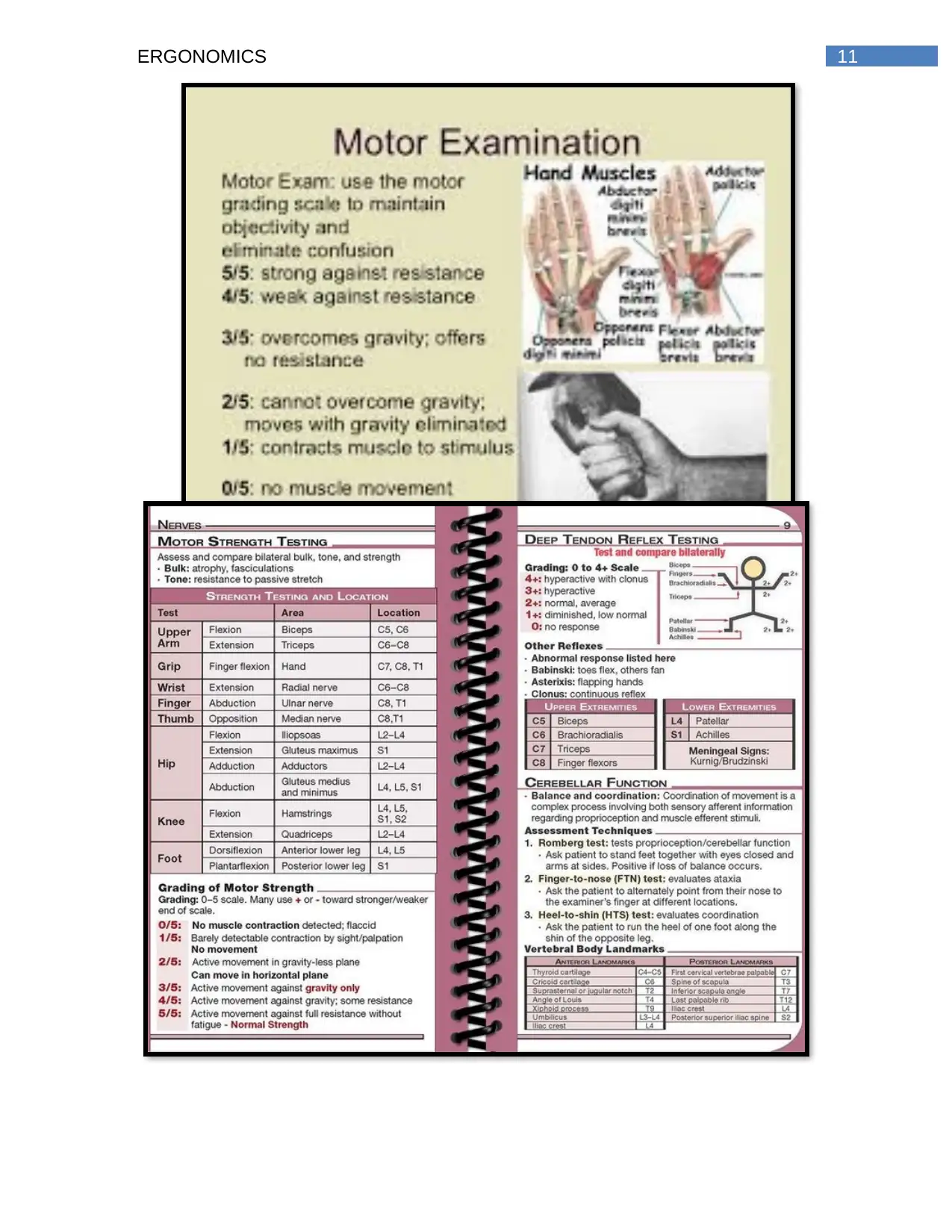
11ERGONOMICS
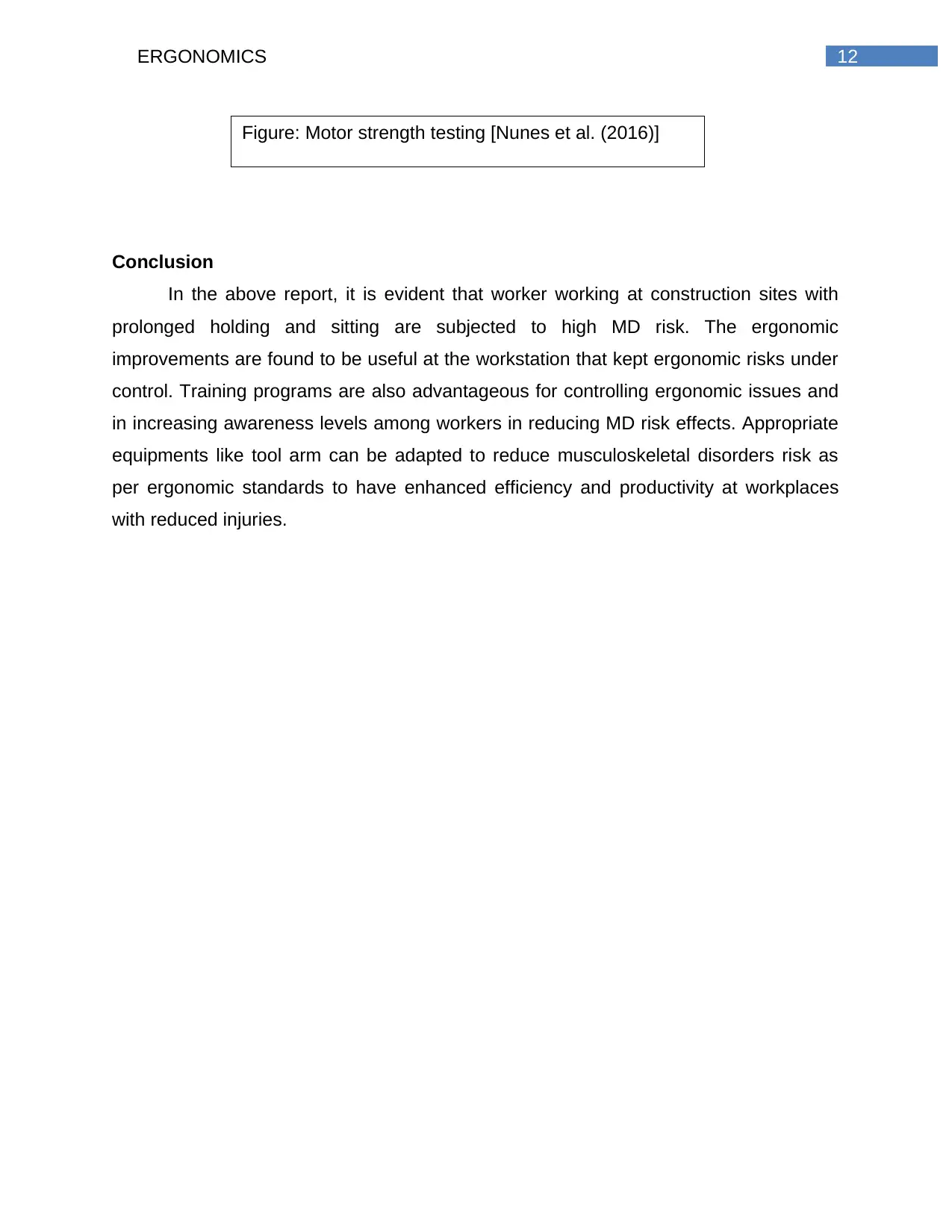
12ERGONOMICS
Conclusion
In the above report, it is evident that worker working at construction sites with
prolonged holding and sitting are subjected to high MD risk. The ergonomic
improvements are found to be useful at the workstation that kept ergonomic risks under
control. Training programs are also advantageous for controlling ergonomic issues and
in increasing awareness levels among workers in reducing MD risk effects. Appropriate
equipments like tool arm can be adapted to reduce musculoskeletal disorders risk as
per ergonomic standards to have enhanced efficiency and productivity at workplaces
with reduced injuries.
Figure: Motor strength testing [Nunes et al. (2016)]
Conclusion
In the above report, it is evident that worker working at construction sites with
prolonged holding and sitting are subjected to high MD risk. The ergonomic
improvements are found to be useful at the workstation that kept ergonomic risks under
control. Training programs are also advantageous for controlling ergonomic issues and
in increasing awareness levels among workers in reducing MD risk effects. Appropriate
equipments like tool arm can be adapted to reduce musculoskeletal disorders risk as
per ergonomic standards to have enhanced efficiency and productivity at workplaces
with reduced injuries.
Figure: Motor strength testing [Nunes et al. (2016)]
Paraphrase This Document
Need a fresh take? Get an instant paraphrase of this document with our AI Paraphraser

13ERGONOMICS
References
Fischer, D., Hafner, P., Rubino, D., Schmid, M., Neuhaus, C., Jung, H., Bieri, O., Haas,
T., Gloor, M., Fischmann, A. and Bonati, U., 2016. The 6-minute walk test, motor
function measure and quantitative thigh muscle MRI in Becker muscular dystrophy: A
cross-sectional study. Neuromuscular Disorders, 26(7), pp.414-422. Motor function test
is a validated test for clinical assessment in musculoskeletal disorders like muscular
dystrophy as it provides validated clinical scores.
Golabchi, A., Han, S., Seo, J., Han, S., Lee, S. and Al-Hussein, M., 2015. An automated
biomechanical simulation approach to ergonomic job analysis for workplace
design. Journal of Construction Engineering and Management, 141(8), p.04015020.
Workplace designing is an ergonomic approach for the reduction in musculoskeletal
injuries or occupational injuries. Risk assessment for musculoskeletal injuries helps to
estimate internal injuries and motion of selected joints of worker.
Kincl, L.D., Anton, D., Hess, J.A. and Weeks, D.L., 2016. Safety voice for ergonomics
(SAVE) project: protocol for a workplace cluster-randomized controlled trial to reduce
musculoskeletal disorders in masonry apprentices. BMC public health, 16(1), p.362.
Landfeldt, E., Lindgren, P., Bell, C.F., Guglieri, M., Straub, V., Lochmüller, H. and
Bushby, K., 2016. Health‐related quality of life in patients with Duchenne muscular
dystrophy: a multinational, cross‐sectional study. Developmental Medicine & Child
Neurology, 58(5), pp.508-515.
Mah, J.K., Korngut, L., Dykeman, J., Day, L., Pringsheim, T. and Jette, N., 2014. A
systematic review and meta-analysis on the epidemiology of Duchenne and Becker
muscular dystrophy. Neuromuscular Disorders, 24(6), pp.482-491. Among the
musculoskeletal disorders, DMD are more prevalent than BMD according to global
estimates as well as case ascertainment sources.
References
Fischer, D., Hafner, P., Rubino, D., Schmid, M., Neuhaus, C., Jung, H., Bieri, O., Haas,
T., Gloor, M., Fischmann, A. and Bonati, U., 2016. The 6-minute walk test, motor
function measure and quantitative thigh muscle MRI in Becker muscular dystrophy: A
cross-sectional study. Neuromuscular Disorders, 26(7), pp.414-422. Motor function test
is a validated test for clinical assessment in musculoskeletal disorders like muscular
dystrophy as it provides validated clinical scores.
Golabchi, A., Han, S., Seo, J., Han, S., Lee, S. and Al-Hussein, M., 2015. An automated
biomechanical simulation approach to ergonomic job analysis for workplace
design. Journal of Construction Engineering and Management, 141(8), p.04015020.
Workplace designing is an ergonomic approach for the reduction in musculoskeletal
injuries or occupational injuries. Risk assessment for musculoskeletal injuries helps to
estimate internal injuries and motion of selected joints of worker.
Kincl, L.D., Anton, D., Hess, J.A. and Weeks, D.L., 2016. Safety voice for ergonomics
(SAVE) project: protocol for a workplace cluster-randomized controlled trial to reduce
musculoskeletal disorders in masonry apprentices. BMC public health, 16(1), p.362.
Landfeldt, E., Lindgren, P., Bell, C.F., Guglieri, M., Straub, V., Lochmüller, H. and
Bushby, K., 2016. Health‐related quality of life in patients with Duchenne muscular
dystrophy: a multinational, cross‐sectional study. Developmental Medicine & Child
Neurology, 58(5), pp.508-515.
Mah, J.K., Korngut, L., Dykeman, J., Day, L., Pringsheim, T. and Jette, N., 2014. A
systematic review and meta-analysis on the epidemiology of Duchenne and Becker
muscular dystrophy. Neuromuscular Disorders, 24(6), pp.482-491. Among the
musculoskeletal disorders, DMD are more prevalent than BMD according to global
estimates as well as case ascertainment sources.
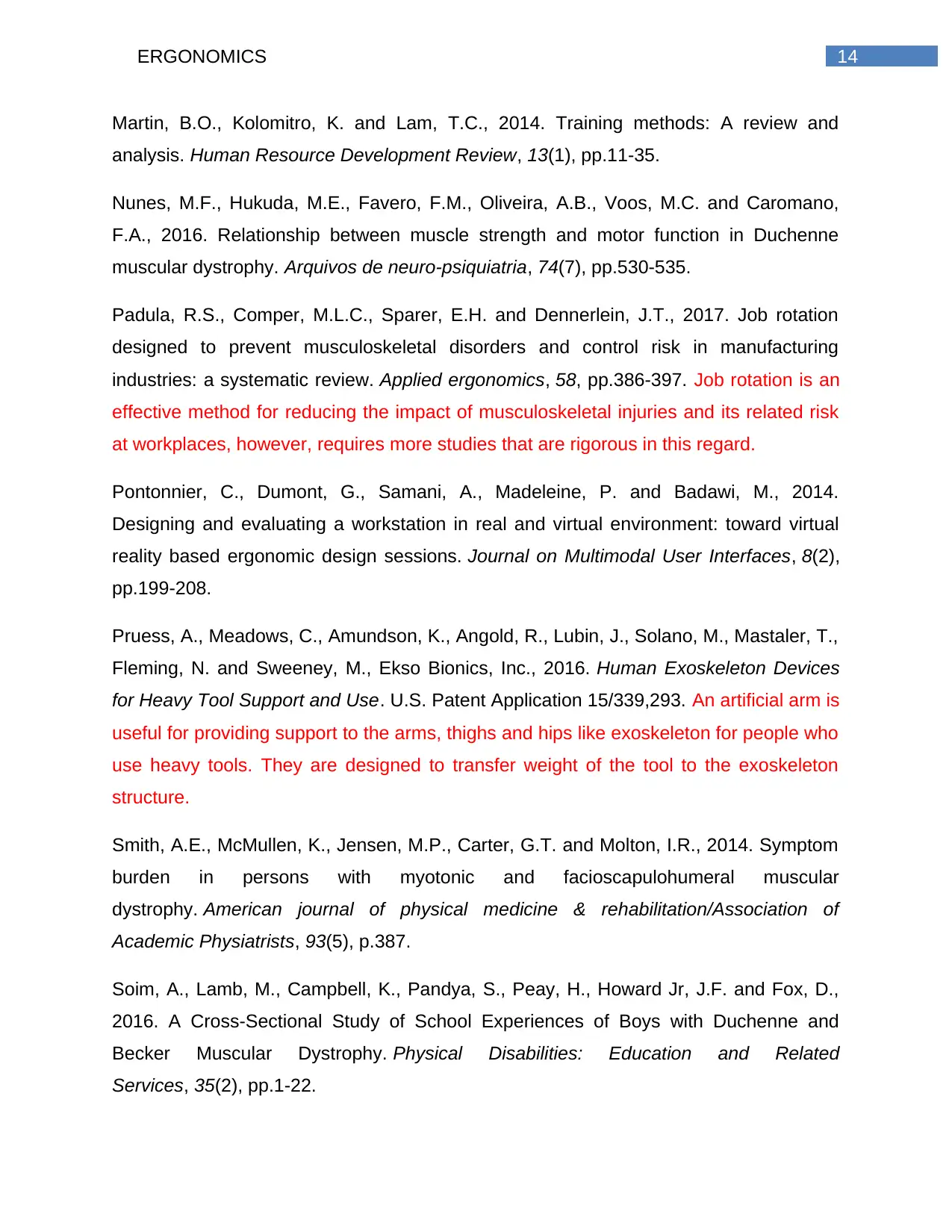
14ERGONOMICS
Martin, B.O., Kolomitro, K. and Lam, T.C., 2014. Training methods: A review and
analysis. Human Resource Development Review, 13(1), pp.11-35.
Nunes, M.F., Hukuda, M.E., Favero, F.M., Oliveira, A.B., Voos, M.C. and Caromano,
F.A., 2016. Relationship between muscle strength and motor function in Duchenne
muscular dystrophy. Arquivos de neuro-psiquiatria, 74(7), pp.530-535.
Padula, R.S., Comper, M.L.C., Sparer, E.H. and Dennerlein, J.T., 2017. Job rotation
designed to prevent musculoskeletal disorders and control risk in manufacturing
industries: a systematic review. Applied ergonomics, 58, pp.386-397. Job rotation is an
effective method for reducing the impact of musculoskeletal injuries and its related risk
at workplaces, however, requires more studies that are rigorous in this regard.
Pontonnier, C., Dumont, G., Samani, A., Madeleine, P. and Badawi, M., 2014.
Designing and evaluating a workstation in real and virtual environment: toward virtual
reality based ergonomic design sessions. Journal on Multimodal User Interfaces, 8(2),
pp.199-208.
Pruess, A., Meadows, C., Amundson, K., Angold, R., Lubin, J., Solano, M., Mastaler, T.,
Fleming, N. and Sweeney, M., Ekso Bionics, Inc., 2016. Human Exoskeleton Devices
for Heavy Tool Support and Use. U.S. Patent Application 15/339,293. An artificial arm is
useful for providing support to the arms, thighs and hips like exoskeleton for people who
use heavy tools. They are designed to transfer weight of the tool to the exoskeleton
structure.
Smith, A.E., McMullen, K., Jensen, M.P., Carter, G.T. and Molton, I.R., 2014. Symptom
burden in persons with myotonic and facioscapulohumeral muscular
dystrophy. American journal of physical medicine & rehabilitation/Association of
Academic Physiatrists, 93(5), p.387.
Soim, A., Lamb, M., Campbell, K., Pandya, S., Peay, H., Howard Jr, J.F. and Fox, D.,
2016. A Cross-Sectional Study of School Experiences of Boys with Duchenne and
Becker Muscular Dystrophy. Physical Disabilities: Education and Related
Services, 35(2), pp.1-22.
Martin, B.O., Kolomitro, K. and Lam, T.C., 2014. Training methods: A review and
analysis. Human Resource Development Review, 13(1), pp.11-35.
Nunes, M.F., Hukuda, M.E., Favero, F.M., Oliveira, A.B., Voos, M.C. and Caromano,
F.A., 2016. Relationship between muscle strength and motor function in Duchenne
muscular dystrophy. Arquivos de neuro-psiquiatria, 74(7), pp.530-535.
Padula, R.S., Comper, M.L.C., Sparer, E.H. and Dennerlein, J.T., 2017. Job rotation
designed to prevent musculoskeletal disorders and control risk in manufacturing
industries: a systematic review. Applied ergonomics, 58, pp.386-397. Job rotation is an
effective method for reducing the impact of musculoskeletal injuries and its related risk
at workplaces, however, requires more studies that are rigorous in this regard.
Pontonnier, C., Dumont, G., Samani, A., Madeleine, P. and Badawi, M., 2014.
Designing and evaluating a workstation in real and virtual environment: toward virtual
reality based ergonomic design sessions. Journal on Multimodal User Interfaces, 8(2),
pp.199-208.
Pruess, A., Meadows, C., Amundson, K., Angold, R., Lubin, J., Solano, M., Mastaler, T.,
Fleming, N. and Sweeney, M., Ekso Bionics, Inc., 2016. Human Exoskeleton Devices
for Heavy Tool Support and Use. U.S. Patent Application 15/339,293. An artificial arm is
useful for providing support to the arms, thighs and hips like exoskeleton for people who
use heavy tools. They are designed to transfer weight of the tool to the exoskeleton
structure.
Smith, A.E., McMullen, K., Jensen, M.P., Carter, G.T. and Molton, I.R., 2014. Symptom
burden in persons with myotonic and facioscapulohumeral muscular
dystrophy. American journal of physical medicine & rehabilitation/Association of
Academic Physiatrists, 93(5), p.387.
Soim, A., Lamb, M., Campbell, K., Pandya, S., Peay, H., Howard Jr, J.F. and Fox, D.,
2016. A Cross-Sectional Study of School Experiences of Boys with Duchenne and
Becker Muscular Dystrophy. Physical Disabilities: Education and Related
Services, 35(2), pp.1-22.
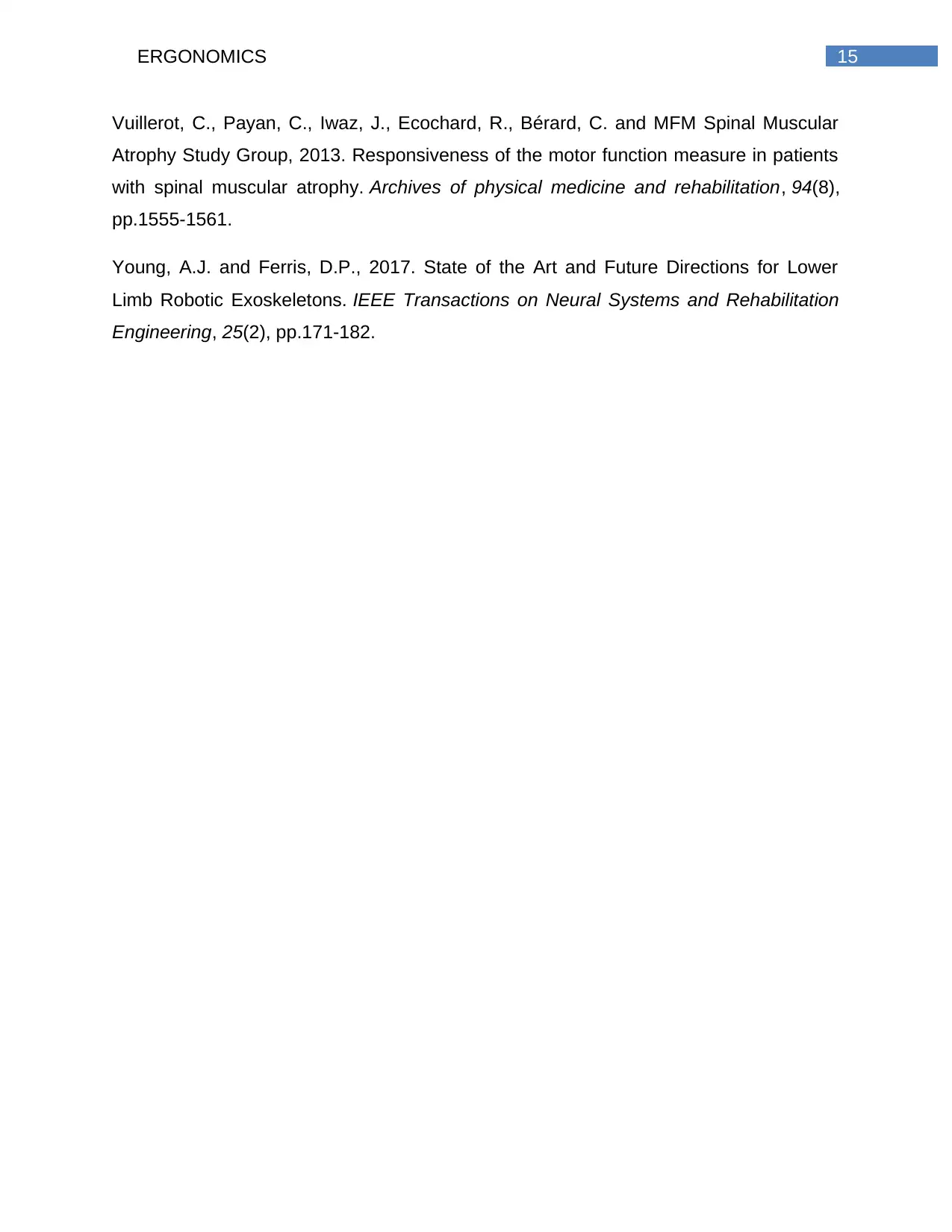
15ERGONOMICS
Vuillerot, C., Payan, C., Iwaz, J., Ecochard, R., Bérard, C. and MFM Spinal Muscular
Atrophy Study Group, 2013. Responsiveness of the motor function measure in patients
with spinal muscular atrophy. Archives of physical medicine and rehabilitation, 94(8),
pp.1555-1561.
Young, A.J. and Ferris, D.P., 2017. State of the Art and Future Directions for Lower
Limb Robotic Exoskeletons. IEEE Transactions on Neural Systems and Rehabilitation
Engineering, 25(2), pp.171-182.
Vuillerot, C., Payan, C., Iwaz, J., Ecochard, R., Bérard, C. and MFM Spinal Muscular
Atrophy Study Group, 2013. Responsiveness of the motor function measure in patients
with spinal muscular atrophy. Archives of physical medicine and rehabilitation, 94(8),
pp.1555-1561.
Young, A.J. and Ferris, D.P., 2017. State of the Art and Future Directions for Lower
Limb Robotic Exoskeletons. IEEE Transactions on Neural Systems and Rehabilitation
Engineering, 25(2), pp.171-182.
1 out of 16
Your All-in-One AI-Powered Toolkit for Academic Success.
+13062052269
info@desklib.com
Available 24*7 on WhatsApp / Email
![[object Object]](/_next/static/media/star-bottom.7253800d.svg)
Unlock your academic potential
© 2024 | Zucol Services PVT LTD | All rights reserved.
